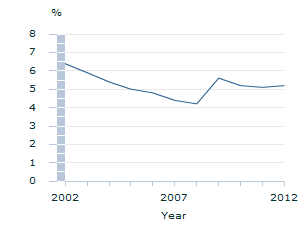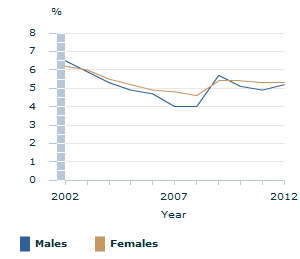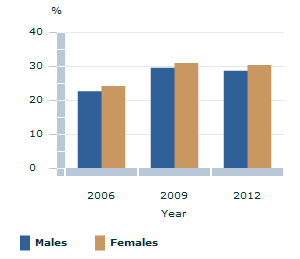|
|
|
This page contains the following further information for jobs:
|
|
GLOSSARY
Average (mean) earnings
The amount obtained by dividing the total earnings of a group (e.g. full-time employees) by the number of employees in that group.
Agreement to work flexible hours
An agreement that is either in writing or otherwise. A written agreement can be in the form of, but not limited to, an individual written agreement between an employer and employee, or a Collective Agreement or Certified Agreement (CA) made directly between an employer and a group of employees.
Disputes
An industrial dispute is defined as a state of disagreement over an issue or group of issues between an employer and its employees, which results in employees ceasing work. Industrial disputes comprise strikes, which are a withdrawal from work by a group of employees; and lockouts, which are a refusal by an employer or group of employers to permit some or all of their employees to work.
Employed
All persons aged 15 years and over who, during the reference week:
- worked for one hour or more for pay, profit, commission or payment in kind in a job or business, or on a farm (comprising employees, employers and own account workers); or
- worked for one hour or more without pay in a family business or on a farm (i.e. contributing family workers); or
- were employees who had a job but were not at work and were:
- away from work for fewer than four weeks up to the end of the reference week; or
- away from work for more than four weeks up to the end of the reference week and received pay for some or all of the four week period to the end of the reference week; or
- away from work as a standard work or shift arrangement; or
- on strike or locked out; or
- on workers' compensation and expected to return to their job; or
- were employers or own account workers, who had a job, business or farm, but were not at work.
Employee
A person who works for a public or private employer and receives remuneration in wages, salary, a retainer fee from their employer while working on a commission basis, tips, piece-rates, or payment in kind; or a person who operates his or her own incorporated enterprise with or without hiring employees (ABS 2007).
Full time workers
Employed persons who usually worked 35 hours or more a week (in all jobs) and those who, although usually working fewer than 35 hours a week, worked 35 hours or more during the reference week.
Labour force
For any group, persons who were employed or unemployed, as defined.
Labour force status
A classification of the civilian population aged 15 years and over into employed, unemployed or not in the labour force, as defined. The definitions conform closely to the international standard definitions adopted by the International Conferences of Labour Statisticians.
Labour force underutilisation rate
The sum of the number of persons unemployed and the number of persons in underemployment, expressed as a proportion of the labour force.
Long-term unemployed
The number of persons unemployed for 52 weeks or over.
Long-term unemployment ratio
The number of long-term unemployed persons, expressed as a percentage of the total unemployed population.
Managerial employees
Employees who have strategic responsibilities in the conduct or operations of the organisation and/or are in charge of a significant number of employees. These employees usually do not have an entitlement to paid overtime. Includes professionally qualified staff who primarily perform managerial tasks in conjunction with utilising their professional skills. Owner managers of incorporated enterprises are regarded as managerial employees.
Not in labour force
Persons who were not in the categories employed or unemployed, as defined.
Participation rate
For any group, the labour force expressed as a percentage of the civilian population aged 15 years and over in the same group.
Part time workers
Employed persons who usually worked fewer than 35 hours a week (in all jobs) and either did so during the reference week or were not at work during the reference week.
Serious claim
A workers’ compensation claim for a death, permanent incapacity, or a temporary incapacity requiring an absence from work of one working week or more lodged in the reference year, and accepted for compensation by the jurisdiction by the date the data are extracted for publication. Claims in receipt of common law payments are also included. Each jurisdiction has its own definition of permanent incapacity. It may include total incapacity for work or a permanent impairment requiring a change of tasks. Claims arising from a journey to or from work are only compensable in some jurisdictions, so they are excluded from the analysis in this publication.
Underemployment rate
The number of underemployed workers expressed as a percentage of the labour force.
Underemployed workers
Employed persons aged 15 years and over who want, and are available for, more hours of work than they currently have. They comprise:
- persons employed part time who want to work more hours and are available to start work with more hours, either in the reference week or in the four weeks subsequent to the survey; or
- persons employed full time who worked part time hours in the reference week for economic reasons (such as being stood down or insufficient work being available). It is assumed that these people wanted to work full time in the reference week and would have been available to do so.
Unemployed
Persons aged 15 years and over who were not employed during the reference week, and:
- had actively looked for full time or part time work at any time in the four weeks up to the end of the reference week and were available for work in the reference week; or
- were waiting to start a new job within four weeks from the end of the reference week and could have started in the reference week if the job had been available then.
Working days lost
Working days lost refers to working days lost by employees directly and indirectly involved in the dispute.
Working days lost per employee involved
The average number of working days lost per employee involved in the dispute, calculated by dividing the number of working days lost in the dispute by the number of employees involved (both directly and indirectly).
Working days lost per thousand employees
Working days lost per thousand employees are calculated for a quarterly period by dividing the total number of working days lost in the period by the total number of employees in the Australian labour force in the period (obtained from the ABS Labour Force Survey (LFS)) and multiplying by 1,000. LFS employee estimates are revised periodically. As a result, estimates of working days lost per thousand employees are also subject to revision.
|
|
There are no references for this theme
|
Click on the links below to be taken to a summary of the graphs from the corresponding tab within the jobs theme:
Overall progress?
Income
Job satisfaction
Flexible arrangements
Safe and healthy working conditions
Effective industrial relations environment
|
| OVERALL PROGRESS? |
 |
Unemployment rate(a) |
 |  |  |
 |  |  |
Headline progress indicator |  | ...by sex |

Footnote:
(a) Annual average.
Source:
ABS Labour Force, Australia (cat. no. 6202.0) |  | 
Footnote:
(a) Annual average.
Source:
ABS Labour Force, Australia (cat. no. 6202.0) |
 |  | |
...over the longer term |  |  |

Footnote:
(a) Annual average.
Source:
ABS Labour Force, Australia (cat. no. 6202.0) |  |  |
 |  | |
|
| INCOME |
 |
Non-managerial jobs(a) that are low paid(b) |
 |  |  |
 |  |  |
Progress indicator |  | ...by sex |

Footnote:
a) A non-managerial job is considered low paid if hourly cash earnings received is less than or equal to two-thirds the median hourly cash earnings for all non-managerial jobs.
(b) Data is for May except 2008 data which is for August.
Source:
ABS data available on request, Survey of Employee Earnings and Hours |  | 
Footnote:
a) A non-managerial job is considered low paid if hourly cash earnings received is less than or equal to two-thirds the median hourly cash earnings for all non-managerial jobs.
(b) Data is for May except 2008 data which is for August.
Source:
ABS data available on request, Survey of Employee Earnings and Hours |
 |  | |
|
| JOB SATISFACTION |
 |
Mean job satisfaction |
 |  |  |
 |  |  |
Progress indicator |  | ...by sex |

Footnote:
(a) Mean score out of 10.
Source:
The Melbourne Institute of Applied Economic and Social Research 2012, Household, Income and Labour Dynamics in Australia Survey: Families, Incomes and Jobs, Volume 7 |  | 
Footnote:
(a) Mean score out of 10.
Source:
The Melbourne Institute of Applied Economic and Social Research 2012, Household, Income and Labour Dynamics in Australia Survey: Families, Incomes and Jobs, Volume 7 |
 |  | |
...with total pay by sex |  |  |

Footnote:
(a) Mean score out of 10.
Source:
The Melbourne Institute of Applied Economic and Social Research 2012, Household, Income and Labour Dynamics in Australia Survey: Families, Incomes and Jobs, Volume 7 |  |  |
 |  | |
|
| FLEXIBLE ARRANGEMENTS |
 |  |  |
Employees(a) that have an agreement(b) with employer to work flexible hours |
 |  |  |
 |  |  |
Progress indicator |  | ...part-time employees by sex |

Footnote:
(a) Excludes owner managers of incorporated enterprises (OMIEs).
(b) Includes both written and unwritten agreements.
Source:
ABS Working Time Arrangements, Australia, November 2012 (cat. no. 6342.0) |  | 
Footnote:
(a) Excludes owner managers of incorporated enterprises (OMIEs).
(b) Includes both written and unwritten agreements.
Source:
ABS Working Time Arrangements, Australia, November 2012 (cat. no. 6342.0) |
...full-time employees by sex |  |  |

Footnote:
(a) Excludes owner managers of incorporated enterprises (OMIEs).
(b) Includes both written and unwritten agreements.
Source:
ABS Working Time Arrangements, Australia, November 2012 (cat. no. 6342.0) |  |  |
 |  | |
|
| SAFE AND HEALTHY WORKING CONDITIONS |
 |  |  |
Serious claims accepted for workers compensation by employees(a) |
 |  |  |
 |  |  |
Progress indicator |  | ...by sex |

Footnote:
(a) Data for 2010-11 is preliminary and likely to increase as more claims are accepted or amended by jurisdictions at a later date.
(b) Calculated as serious claims per 1000 employees.
Source:
Safe Work Australia 2013, Compendium of Workers' Compensation Statistics Australia 2010-11 |  | 
Footnote:
(a) Data for 2010-11 is preliminary and likely to increase as more claims are accepted or amended by jurisdictions at a later date.
(b) Calculated as serious claims per 1000 employees.
Source:
Safe Work Australia 2013, Compendium of Workers' Compensation Statistics Australia 2010-11 |
...frequency rate |  |  |

Footnote:
(a) Data for 2010-11 is preliminary and likely to increase as more claims are accepted or amended by jurisdictions at a later date.
(b) Calculated as serious claims per million hours worked.
Source:
Safe Work Australia 2013, Compendium of Workers' Compensation Statistics Australia 2010-11 |  |  |
 |  | |
|
| EFFECTIVE INDUSTRIAL RELATIONS ENVIRONMENT |
 |  |  |
Industrial disputes |
 |  |  |
 |  |  |
Progress indicator(a)(b) |  | Working days lost per 1000 employees |

Footnote:
(a) Total number of disputes is all the disputes which belong to the relevant period.
(b) Industrial disputes are included within the scope if the work stoppages amount to ten or more working days lost. Disputes which involve the equivalent of less than 10 working days lost are excluded.
Source:
ABS Industrial Disputes, Australia, Jun 2013 (cat. no. 6321.0.55.001) |  | 
Source:
ABS Industrial Disputes, Australia, Jun 2013 (cat. no. 6321.0.55.001) |
 |  | |
|
|
|
|